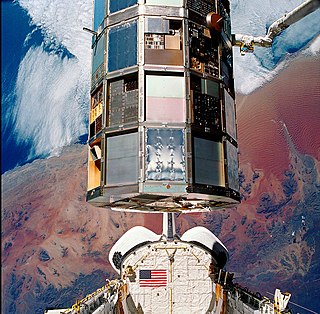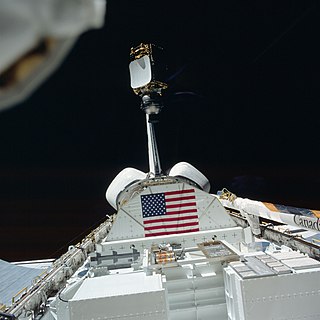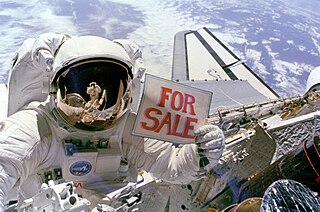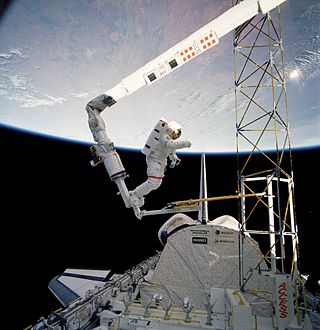
The Space Shuttle is a retired, partially reusable low Earth orbital spacecraft system operated from 1981 to 2011 by the U.S. National Aeronautics and Space Administration (NASA) as part of the Space Shuttle program. Its official program name was Space Transportation System (STS), taken from a 1969 plan for a system of reusable spacecraft where it was the only item funded for development.
The Long March rockets are a family of expendable launch system rockets operated by the China Aerospace Science and Technology Corporation. The rockets are named after the Chinese Red Army's 1934–35 Long March military retreat during the Chinese Civil War.

STS-32 was the 33rd mission of NASA's Space Shuttle program, and the ninth launch of Space ShuttleColumbia. Launched on January 9, 1990, it marked the first use of the Launch Complex 39A of Kennedy Space Center at since 1986; it also marked the first use of Mobile Launcher Platform-3 (MLP-3) in the Space Shuttle program. STS-32 was, at the time, the longest shuttle mission yet conducted, with a duration of nearly 11 days. Before STS-32, the only mission of the same duration had been STS-9 in 1983. On January 20, 1990, STS-32 executed the third night landing of the shuttle program. STS-32 was also the first Shuttle mission of the 1990s.

STS-8 was the eighth NASA Space Shuttle mission and the third flight of the Space Shuttle Challenger. It launched on August 30, 1983, and landed on September 5, 1983, conducting the first night launch and night landing of the Space Shuttle program. It also carried the first African-American astronaut, Guion Bluford. The mission successfully achieved all of its planned research objectives, but was marred by the subsequent discovery that a solid-fuel rocket booster had almost malfunctioned catastrophically during the launch.

STS-41-B was NASA's tenth Space Shuttle mission and the fourth flight of the Space ShuttleChallenger. It launched on 3 February 1984, and landed on 11 February 1984 after deploying two communications satellites. It was also notable for including the first untethered spacewalk.

STS-51-A was the 14th flight of NASA's Space Shuttle program, and the second flight of Space Shuttle Discovery. The mission launched from Kennedy Space Center on November 8, 1984, and landed just under eight days later on November 16, 1984.

STS-51-G was the 18th flight of NASA's Space Shuttle program, and the fifth flight of Space Shuttle Discovery. The seven-day mission launched from Kennedy Space Center, Florida, on June 17, 1985, and landed at Edwards Air Force Base, California, on June 24, 1985. Sultan bin Salman Al Saud from Saudi Arabia was on board as a payload specialist; Al Saud became the first Arab, the first Muslim, and the first member of a royal family to fly into space. It was also the first Space Shuttle mission which flew without at least one astronaut from the pre-Shuttle era among its crew.

STS-61-B was NASA's 23rd Space Shuttle mission, and its second using Space Shuttle Atlantis. The shuttle was launched from Kennedy Space Center, Florida, on November 26, 1985. During STS-61-B, the shuttle crew deployed three communications satellites, and tested techniques of constructing structures in orbit. Atlantis landed at Edwards Air Force Base, California, at 16:33:49 EST on December 3, 1985, after 6 days, 21 hours, 4 minutes, and 49 seconds in orbit.

Joseph Percival "Joe" Allen IV is a former NASA astronaut. He logged more than 3,000 hours flying time in jet aircraft.
![<span class="mw-page-title-main">STS-61-H</span> [[Canceled Space Shuttle missions|Canceled Space Shuttle mission]]](https://upload.wikimedia.org/wikipedia/commons/thumb/3/3e/Shuttle_Patch.png/320px-Shuttle_Patch.png)
STS-61-H was a NASA Space Shuttle mission planned to launch on 24 June 1986 using Columbia. However, it was canceled due to the Challenger disaster.

Westar 1 was America's first domestic and commercially launched geostationary communications satellite, launched by Western Union (WU) and NASA on April 13, 1974. It was built by Hughes for Western Union, using the HS-333 platform of spin-stabilized satellites. It operated until May 1983.
Westar was a fleet of geosynchronous communications satellites operating in the C band which were launched by Western Union from 1974 to 1984. There were seven Westar satellites in all, with five of them launched and operating under the Westar name.
AsiaSat 3, previously known as HGS-1 and then PAS-22, was a geosynchronous communications satellite, which was salvaged from an unusable geosynchronous transfer orbit (GTO) by means of the Moon's gravity.

Palapa is a series of Communications satellites owned by Indosat, an Indonesian telecommunications company. Starting with the first in July 1976, at which time Indonesia became the first developing country to operate its own domestic satellite system. The estimated cost for the project was US$1 billion.

SBS 4 was a geostationary communications satellite designed and manufactured by Hughes on the HS-376 platform. It was ordered by Satellite Business Systems, which later sold it to Hughes Communications. It had a Ku band payload and operated at 94°W longitude.
AsiaSat 2 was a Hong Kong communications satellite, which was owned, and was initially operated, by the Hong Kong based Asia Satellite Telecommunications Company. It was positioned in geostationary orbit at a longitude of 17° East of the Greenwich Meridian, on lease to Spacecom. It spent most of its operational life at 100.5° East, from where it was used to provide fixed satellite services, including broadcasting, audio and data transmission, to Asia and the Pacific Ocean.
The Long March 2E, also known as the Chang Zheng 2E, CZ-2E and LM-2E, was a Chinese orbital carrier rocket from the Long March 2 family. The Long March 2E was a three-stage carrier rocket that was designed to launch commercial communications satellites into geosynchronous transfer orbit. Launches took place from launch complex 2 at the Xichang Satellite Launch Center.

The Morelos satellites are a series of Mexican communications satellites. The first two operated between 1985 and 1998 and provided telephony, data, and television services over the territory of the Mexican Republic and adjacent areas. The third is now part of the MEXSAT constellation but carries the Morelos name.
Paksat-1R is a geosynchronous, communications satellite that was manufactured by China Great Wall Industry Corporation (CGWIC) and operated by the Space and Upper Atmosphere Research Commission (SUPARCO), an executive space authority of the Government of Pakistan.

TDRS-B was an American communications satellite, of first generation, which was to have formed part of the Tracking and Data Relay Satellite System. It was destroyed in 1986 when the Space ShuttleChallenger disintegrated 73 seconds after launch.








![<span class="mw-page-title-main">STS-61-H</span> [[Canceled Space Shuttle missions|Canceled Space Shuttle mission]]](https://upload.wikimedia.org/wikipedia/commons/thumb/3/3e/Shuttle_Patch.png/320px-Shuttle_Patch.png)




